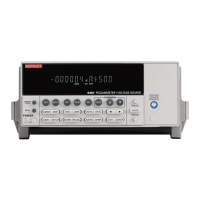8-20 Limit Tests and Digital I/O Model 6487 Reference Manual
B) <NDN> and <NRf> parameters
<NDN> = #Bxxxx Binary format (each x = 1 or 0)
= #Hx Hexadecimal format (x = 0 to F)
= #Qxx Octal format (x = 0 to 17)
<NRf> = 0 to 15 Decimal format
An output pattern is set by sending a parameter value that corresponds to the 4-bit BCD
pattern of the output. The parameter value can be sent in the binary, decimal, hexadecimal,
or octal format. For example, if you wish to set lines 4, 2, and 1 HI, the binary parameter
value would be 1011. To use one of the other formats, convert the binary number to its
decimal, hexadecimal, or octal equivalent:
Binary 1011 = Decimal 11 = Hexadecimal B = Octal 13
The <NDN> (non-decimal numeric) parameter type is used to send non-decimal values.
These values require a header (#B, #H, or #Q) to identify the data format being sent. The
letter in the header can be upper or lower case. The <NRf> (numeric representation for-
mat) parameter type is used to send decimal values and does not use a header.
The following examples show the proper parameter syntax to set an output pattern to 1101
(lines 4, 3, and 1 set HI):
#b1101 Binary format (<NDN> parameter type)
#hD Hexadecimal format (<NDN> parameter type)
#q15 Octal format (<NDN> parameter type)
13 Decimal format (<NRf> parameter type)
klqb When a query command to read a programmed output pattern (i.e.,
CALC2:LIM:UPP:SOUR2?) is sent, the format for the returned value is deter-
mined by the presently selected response message format for output patterns
(see FORMat:SOURce2 command in Table 8-3).
C) :FAIL?
In the event of a failure, you can read the measurement event register to determine which
limit (upper or lower) failed. See Section 10 to program and read the measurement event
register.
D) :DATA? and :DATA:LATest?
The INITiate command must be sent to perform the programmed number of measure-
ments. If the instrument is programmed to perform a finite number of measurements, the
:DATA? command will return all the CALC2 readings after the last reading is taken. The
:DATA:LATest? command will only return the last (latest) CALC2 reading.

